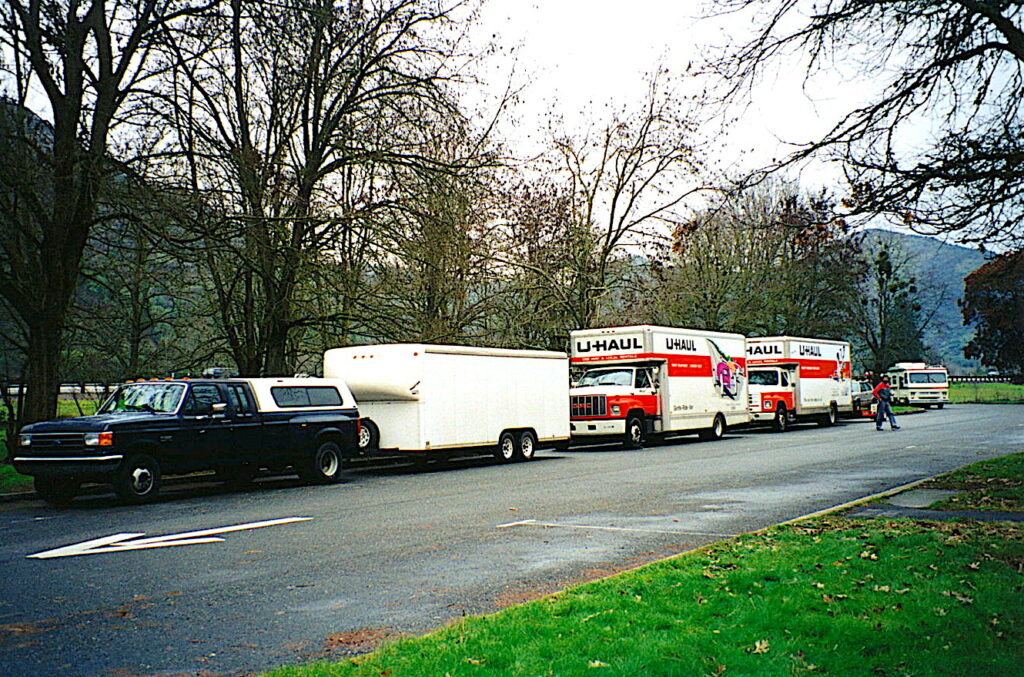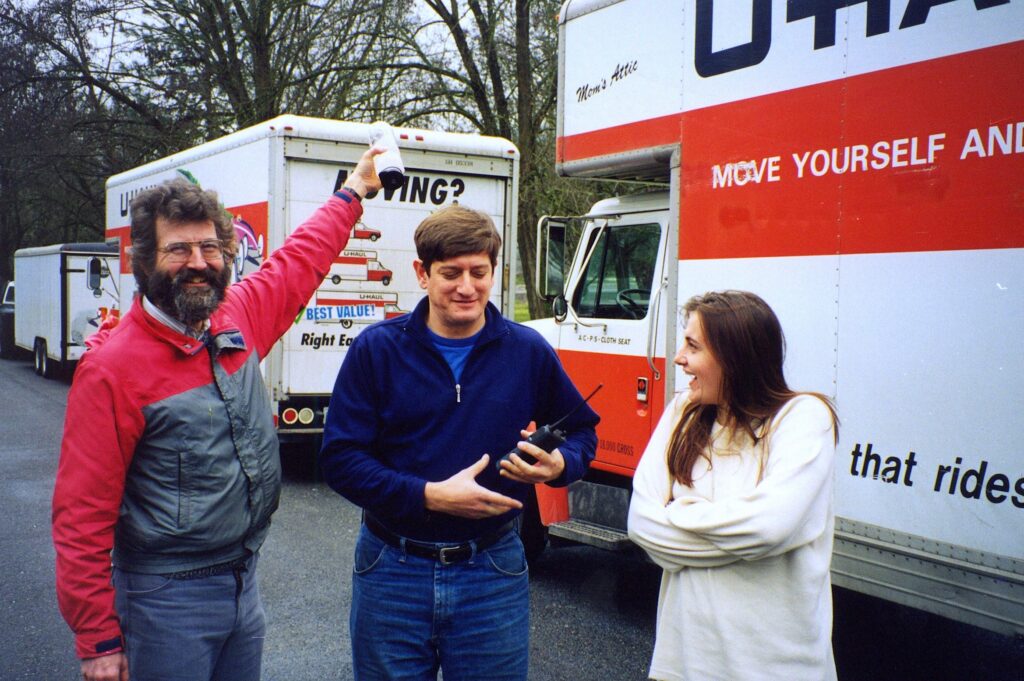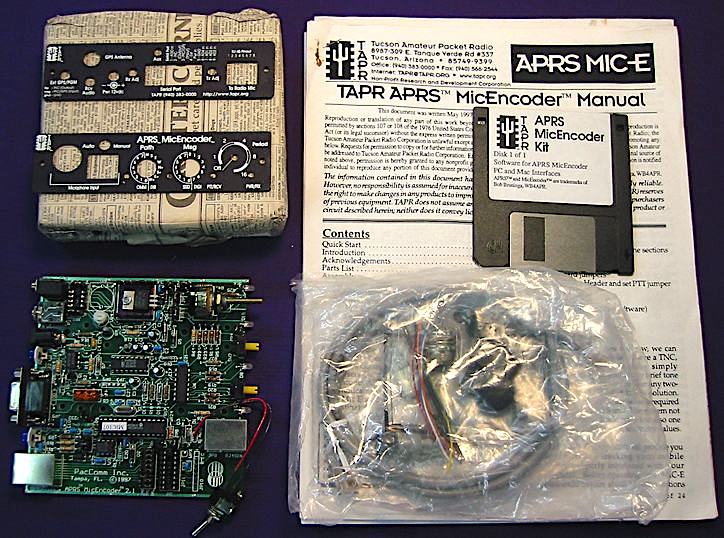
Microship Status 122 – End of an Era
This issue came at a pivotal moment, as we shut down the Apple-sponsored lab in Silicon Valley and moved to the Pacific Northwest to begin the quest for new facilities. The full text of this also ran in Packet Status Register (TAPR) Issue #69.
by Steven K. Roberts
Nomadic Research Labs
Bellingham, Washington
December 31, 1997
“Strange is when the bizarre becomes normal.”
— by (or at least quoted by) Rich Carlson
The End Of An Era
Wooo. 3 frenetic months ago (oops!) at the close of issue #121, I mentioned the impending move from our windowless lab in the heart of Silicon Valley tech-industrial sprawl. My tone was at once nervous and flip… major change loomed in a shape I could not imagine.
Well, it happened. As the end of the lease drew nigh, our world became a bizarre bifurcated reality of fiberglassing and boxing — Bob Stuart’s creative efforts yielding ever more interesting results even as the workspace collapsed around him and his intrepid apprentice, Lisa.
“Where are those neoprene strips you found?” asks Bob, looking to design the gasket interface on the console cowling.
“Ah, just a second.” I scan the moving inventory, already cataloguing the contents of over 200 boxes, find the reference to L-13 (a plum of a dumpster-diving prize, if I do say so myself), and after a few moments’ scurrying slit the tape, tease out a few strips, and thread my way between packed piles and the Zone of Goo to pass them to Bob.
Work continued in this convoluted fashion until the twin mega U-Haul fuel guzzlers rumbled into the parking lot and cozied up next to the Mothership, their gaping maws all in a row, ramps lolling like tongues, hungry for boxes and lab furniture. In an epic weekend, we optimized packing density to the point of exceeding GVWR specs, then hit the road… a convoy of three trucks and two trailers, with 26 wheels on the ground and an aggregate fuel economy of 2.5 miles per gallon. Bob Stuart and Mike Gittelsohn piloted the trucks; I drove the Mothership with Lisa in cargo-mode (still not licensed to drive in the US) — northbound like madmen to Washington at the beginning of winter.

After a nightmarish and bloody day of shoehorning the whole mess into 4,000 cubic feet of storage space north of Bellingham, Mike returned to California and Bob to Salt Spring Island… leaving us to find a building so we can move it all again — this time, presumably, into a permanent Nomadic Research Labs home base. (In addition to the heroic Bob and Mike, who not only loaded and unloaded but drove through 1,000 miles of rain and I-5 torpor, a big THANK YOU goes to the other folks who helped us pack tons of equipment onto the trucks: David Berkstresser, Randy Devol, Andrew Letton, Mark Moorcroft, and Dewayne Hendricks.)
Beauty Emerging…
The first of the Microships, meanwhile, has reached completion of the raw fiberglass fabrication phase… it is amazing what a canoe can become when shaped by bizarrely intertwined design goals!
The first clue that glassing was nearing an end lay in the brainstorming. As moving deadline enforced more and more dedicated activity, conversation took on a new flavor: cowling design, control line management, anchoring options, conversion into sleep mode, pedal drive access, electric thruster deployment, and so on — the focus now on applications and fixtures instead of raw shape and marine architecture. One of Bob’s final projects was slotting the turn of the bilge for the forward-angled daggerboard trunk, the result of hours of analysis concerning the effect of board depth on center of lateral resistance, what happens to center of effort when stiffening winds bend the 19′ freestanding aluminum mast and change helm balance, grounding-induced automatic retraction, dagger stowage when running or not sailing, the layup schedule dictated by worst-case loads, and impact on console space. Every time such a set of decisions was cast in glass, the design grew more stable, the choices ahead more and more constrained and focused on single issues. Odd that the evolution of the design was as much retrospective as proactive… like sailing in the fog, the end wasn’t in sight until it was fast upon us.
Yes, one of the graceful Wenonah canoes has morphed into a trimaran, the kevlar hull flowing into Divinycell-core decks complete with fore and aft hatches with integral D-ring fixtures, bow cleat, Teflon-anodized rotating mast base, cockpit enclosure, angled solar array mating surfaces, cowling interface, aka nests, stern antenna mount, retractable pedal drive nacelle with access cover, integral hard points for pedal bearings, and a sculpted radar arch with embedded traveler track substrate. The whole gestalt is organic and fluid, the curves alluring, the boat solid yet graceful, a study in stress distribution blended with practicality and artistry. On the day before we tucked all six hulls into the Mothership, we stepped the mast and attached the crossbeams in the parking lot… ready to beat to windward across Silicon Valley followed by an exhilarating reach up I-5…
More progress: the recumbent seat, made by Ryan Recumbents, donated by Landstrider Sports Trikes (cool recumbent tricycles), and black-anodized by CSL, is ready to be mounted — with a triangulated back-support structure that allows a wide adjustment range along with a forward coaming-support that lets the seat pivot out of the way for passage into sleep mode or access to the power bay. Moore Sailboats created a pair of elegant lightweight carbon fiber rudders, color-matched to our hulls, and we are now designing the deployment and mounting system. (These sleek foils put the heavy used Nacra daggerboards to shame… but the trunk is designed around them.)
I’m also delighted to report that the quest for wheels is at an end: the folks at Seitech Launching Dollies shipped us eight of their amazingly lightweight 16″ diameter, 4″ wide pneumatic tires on plastic rims with Delrin roller bearings — the best solution we’ve found to a non-corrodible wheel that can handle both pavement and mushy stuff. All we need is a hinged strut assembly and associated control lines, and she’s ready to roll. And I found an Ankarolina on the clearance table at West Marine: 115′ of 3,500-pound test nylon webbing (1″ wide) that will mount on the foredeck and keep the anchor line under control. Much more on all this, of course, as it becomes integrated into these wee boatlets…
Indeed, integration is now becoming the major issue: packaging, weight budget, gear stowage, and line management. Microships are TINY — the only enclosed stowage areas are bow and stern compartments accessed by gasketed deck hatches. There’s a little space around the seat, and a few stowage pockets here and there, but basically, now that we have had plenty of time to stare at this, it is clear we are dealing with on-board equipment inventory on the scale of bicycle touring, not coastal cruising.
From Wheel Estate To Real Estate
All that notwithstanding, we are in the midst of major disruption — the Santa Clara lab is history. For months we were on a quest for sponsored space, sending email proposals to various high-profile CEO’s, trying to get past the bureaucratic barriers to occupying one of over 150 empty buildings at the former Fort Ord site (now a Cal State campus with a healthy environmental engineering program with which we would have dovetailed nicely), and schmoozing various other universities and smaller firms. No luck. We’re now renting a room from which to launch the lab quest, with a full-scale electronics lab, fiberglass shop, small publishing business, two kayaks and two Microships-in-progress, a dozen or so computers, BEHEMOTH, about 20 lab benches/desks, and 350 or so boxes of STUFF… all in cold storage.
It all started about 3 months ago. With the clock relentlessly ticking and Bob working alone in the lab, Lisa and I drove to Washington (we can’t even fantasize about real estate near $ilicon Valley), stopping enroute to check out potentially interesting sites in Northern California and along the Columbia River. One of the latter was particularly amusing — 10,000 square feet of ancient creamery in Gray’s River, WA: a huge riverfront building for only $69K! The catch, of course, is that it’s on a flood plain and gets about 3-4 feet deep once a year, but hey… on that day we could enjoy the luxury of an indoor launch ramp.
We did the real-estate tour on a grand yet hurried scale, home-basing with endlessly delightful old friends on Bainbridge Island and making daily pilgrimages to Whidbey Island, Port Townsend, Port Angeles, Bellingham, and anywhere else that sounded promising. The objective: at least 2,500 square feet of shop building within a walkable mile of a launch site, along with a house that can be rented out to more or less cover the mortgage, providing a long-term home base for this project that will at last eliminate these biennial panic-quests for donated space.
Our first lesson is that in the real estate business, non-quantitative terms have no meaning. We drove excitedly to Quilcene Bay one morning to find a “huge shop” that was a slightly oversized 2-car garage with a dusty workbench along the back wall. “Close to the beach” might apply if you are driving the family car, but not if you are dragging a 600-pound Microship behind your body for a quick test sail. And we learned to be suspicious of lines like “peek-a-boo water view,” “ultimate fixer-upper,” and “open-minded buyers will be intrigued by this unique property.”
One place that was close to meeting spec sold to a horse family while we were pondering it, and then we ran out of time… zooming back down that all-too-familiar I-5 with a side trip to Cameron Park for Lisa’s first experience in a small plane… Brian Lloyd’s 1949 Piper Clipper. We soared out over Gold Country (American River and Placerville), Lisa wide-eyed and delighted by every moment. “I think I’ll skip getting my US Driver’s License,” she said after running an avian circle in the parking lot with arms outstretched childlike, “and go directly to becoming a pilot.”
Uh-ohhhh…
Intrigued by a few calls from realtors over the next week, I turned around and jetted back north alone, this time hot on the trail of a perfect spot — 3,600 sqft of shop a mile from a launch ramp on Birch Bay, with a very rentable house… all on 5 acres for $160K (about $1 million in Silicon Valley real estate dollars). Two visits, lots of video, hours of research… and then the dark truth emerged despite protestations to the contrary by Windermere Real Estate: the pristine vast empty land across the street, stretching all the way to Cherry Point, is zoned Heavy Industrial and slated for development by Trillium Corporation as a deep-water tanker port… with “my” quiet country road the main truck route into the complex. <sigh>
I’ll spare you the details of the rest of our search to date — but it’s beginning to look like the ideal solution is house and land on which we can have a metal building erected… it’s surprisingly inexpensive and is guaranteed to meet my needs (though there is this ultimate fixer-upper on waterfront up in Blaine that keeps teasing through our thoughts, the huge shipyard building a liability to anyone sane, but endlessly enchanting to an “open-minded buyer”).
Damn. Last time I bought a house it inspired a long-distance bicycle adventure…
I should mention, by the way, that the move from Silicon Valley was not merely a financial one. For a wee-boat sailor and kayaker, the water in the Pacific Northwest is rich with promise and intrigue; San Francisco Bay, despite its legendary beauty and stimulating conditions, is nowhere near as open to camping-scale gunkholing as Puget Sound, the San Juans, and the Gulf Islands. Also, the culture has changed over the past decade… though the Valley is still the ultimate refuge of geekdom and a techno-resource mecca, it has become more busy and less playful than it once was. It’s a subtle difference from year to year, and prone to subjectivity, but the Valley has matured and grown serious, trafficking in commodities, busy with startups, collectively tied down by the velvet handcuffs of stock options and buyouts. It no longer feels like a manic grown-up science fair fueled by exuberance, tinged with New Age silliness, and rewarded by surprise riches that barely distract the True Hacker from the endless quest for new limitations to conquer.
So while we will miss Halted, easy access to both surplus and cutting-edge gizmology, and a few brilliant friends, we’re actually excited to be up here in this chilly aquatic wonderland where spontaneous smiles on the street are commonplace and at least a few people still see computers as a labor of love (and no, I’m not talking about Redmond!).
Oh, and speaking of computers…
First Packnet Hacks
This is almost fading into the vapors of memory with all the recent adventures in boat fabrication and lifestyle disruption, but we’ve been refining the spec for the “low-level network” that connects backpacks and on-board control systems. Something has to be alive all the time to handle watchdog polling, security, location tracking, environmental data collection, power monitoring, and other basic functions — without drawing the amps needed by high-speed wireless links, ethernet hub, and high-level systems with their disks merrily a-spinning. It turns out that vanilla ham-radio packet links in the 70cm band are just about ideal — all the applications-level stuff and business traffic can be handled by the Macs under FCC Part 15 while this amateur “packnet” takes care of the toys. (Oh yes… my sweetie just received her Tech license recently… meet KF6NWO, a callsign rich with apropos acronyms.)

Under the present design, each backpack carries a packet TNC and one of the little Motorola GPS receivers, interfaced by a Mic-E from TAPR. This is a small and easily-waterproofed package, capable of coexisting unobtrusively with our person-to-person voice operation while tailing each transmission with a GPS fix along with various flags (if we’re not chatting, the data is sent in short bursts every few minutes). My boat collects all this from each pack as well as Lisa’s boat — allowing a one-button query from any remote to receive a calculated great-circle distance and bearing to any other node as well as basic system status update (delivered via speech synthesizer). And, of course, it becomes possible to remotely power-up the big iron and fast network to allow full control, email, web access, video, or system hackage via the wireless graphic front end.
One of the puzzles that remained was the precise architecture of Lisa’s control node in the context of my multidrop FORTH network, and it turned out to be simple in theory: just hang a PacComm TNC on the node’s console port. As usual, this took quite a bit of fiddling with handshake and flow control options, but finally worked… I could sit at my Mac, connected to a KAM+ and the Icom mobile dual-bander out of my truck via the serial crossbar, and hack FORTH on a battery-powered New Micros board linked to an old HT at the other end of the lab. This proof-of-concept complete, I went no further… back to boat-fabrication and move-planning.
By the way, I mentioned in #121 that PBA offered an RS-232 interface to the Dallas Semiconductor MicroLAN hardware… it has arrived! I’m looking forward to unpacking it and putting it to use…
Hogfish Reprise
We recently experienced an interesting bit of “closure” in another domain… beloved Hogfish, now more aptly named Pelican, is afloat and sailing gracefully. Lisa and I joined the new owners for a spin on the Oakland Estuary a few weeks ago, and the only comparison I can muster that accurately captures the emotional impact of that event is watching a beautiful ex-lover aglow in the company of her new mate. Pelican’s new owners finished the rig with our parts, built the pivoting centerboard trunk, added tramps and a basic suite of cruising accommodations, replaced the rustbucket trailer, and are now presumably somewhere in or near San Diego. <tremulous sigh> Light of helm, fast on her feet, this lovely 30-foot folding trimaran has at last spread her wings and escaped a decade of storage yards and industrial buildings.
But I still think it was the right decision: these wheeled multimodal micro-tris are right for us. They’re small enough to make every sail an adventure, yet just large enough to contain all essential life-support… light enough to haul out with muscle, yet solid enough to see the world… simple enough to be as accessible to strangers as a bicycle, yet insanely complex in that exquisite way that only a True Geek can relish. Pelican, for all her elegance and historical uniqueness, was too much like a yacht for me, even if it did take a year or so for the realization to sink in!
And so, we embark on a new era, somewhere in the Pacific Northwest, establishing a long-term home base from which to wander aboard these tiny networked boats. Lots of new developments are brewing (but a bit too early to publish), and we’re just at the point of forking the project into two parallel threads: the long-awaited console fabrication process now has the green light to proceed since the physical constraints of the boat are at last defined. Once we find a place to plug in the soldering iron, that is…
Cheers and Happy New Year from Nomadic Research Labs!


You must be logged in to post a comment.